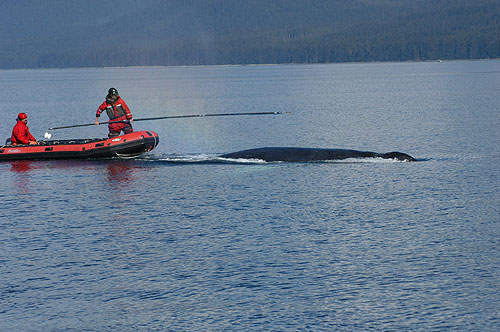
Response team removes more gear from entangled whale, ends efforts
September 06, 2013
“The tail and pectoral fins are free of gear, but the necklace of line behind the blowhole remains,” said Fred Sharpe of the Alaska Whale Foundation, a partner in NOAA Fisheries Alaska Marine Mammal Stranding Network. “We have removed the satellite telemetry buoy.” Alaska Marine Mammal Stranding Network responders John Moran of NOAA Fisheries and Fred Sharpe of the Alaska Whale Foundation. Moran steers the response vessel while Sharpe attempts to cut the netting entangling the humpback whale.
“We want to thank everyone for the remarkable time, effort, and brain trust that went into assisting this whale,” added Sharpe, noting that the Petersburg Marine Mammal Center, Alaska Sea Grant, Alaska Whale Foundation, and the Chichagof Conservation Council all participated in the effort. The humpback whale first became entangled in a tended gillnet in Frederick Sound near Petersburg, Alaska on August 23. A NOAA Fisheries-trained and authorized team from the PMMC and Alaska Sea Grant initially responded and determined the entanglement was life-threatening. Although the Petersburg team could not free the animal, they did manage to attach a satellite buoy so that the whale could be tracked. After moving slowly north most of last week, the whale came within reach of the Juneau response team last weekend, and NOAA Fisheries and the Alaska Whale Foundation mounted multiple disentanglement response efforts. The team took a break early in the week to wait for calmer seas, and to allow time for the whale to relax so that it might be more approachable. NOAA Fisheries is still asking mariners to stay clear of this whale if they spot it, and not to make any unauthorized rescue attempts. Humpback whales are protected under federal law, an only those specifically trained and permitted by NOAA Fisheries are authorized to take such action. If you come across any other entangled marine mammal please call the Alaska Marine Mammal Stranding Hotline at (877) 925-7773, or call the US Coast Guard on Channel 16. They will relay the report. It is typically the tour boat operators, fishers, and other mariners that find the animals and provide the initial assessment that is so valuable toward any response effort.
On the Web:
Source of News:
E-mail your news &
photos to editor@sitnews.us
|
||
